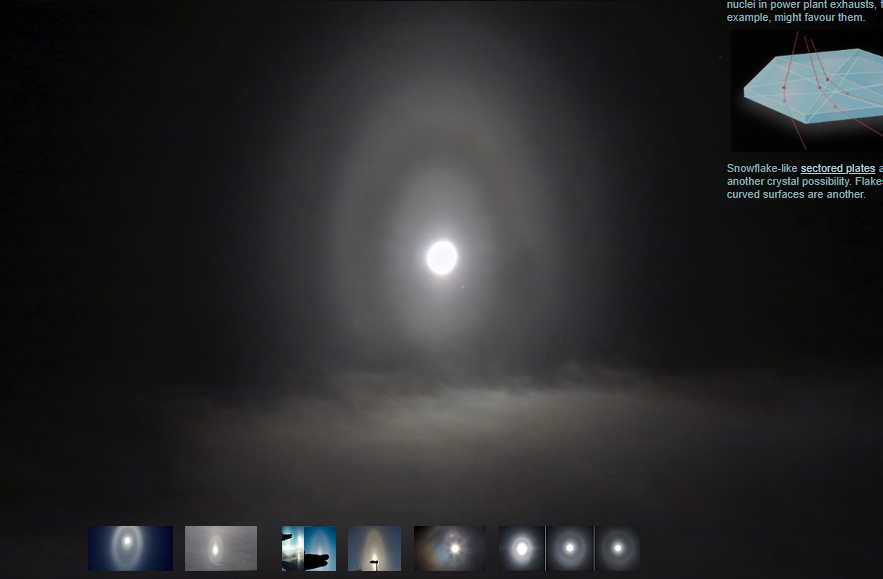Lunar Ellipticsl Halo, Vermont, ASA - OPOD
Lunar Elliptical Halo: A Rare Atmospheric Phenomenon
Lunar elliptical halos, like the one sighted by Stewart King in Bennington, Vermont, USA, are a rare and captivating atmospheric phenomenon. On the 19th of January, '16, at 23:45 local time, with the moon positioned 42° high in the sky, King witnessed this mesmerizing sight. The ground level air temperature at that time was a chilly -9 Celsius. The halo remained visible for several minutes, exhibiting small yet significant changes during that time.
The lunar elliptical halo observed in Vermont was notably smaller compared to the more common 22° halo. In fact, it was merely 1/7th the size, measuring approximately 6° in width. To spot such a halo, it is crucial to shield the sun or moon effectively.
One intriguing aspect of lunar elliptical halos is the crystals responsible for their formation. These crystals pose a challenge to scientists due to their peculiar properties. While computer simulations based on ray paths through plate-like pyramidal crystals initially appear plausible, they do not accurately match real-life observations. Crystallographically speaking, these crystals are improbable. However, this does not discount the possibility of their existence entirely. It is conceivable that these crystals could form as growth nuclei in certain environments, such as power plant exhausts.
There are several crystal possibilities that may contribute to the formation of lunar elliptical halos. One such possibility is snowflake-like sectored plates. These flakes exhibit curved surfaces, providing an alternative mechanism for the creation of these unique atmospheric phenomena.
The images captured by Stewart King provide valuable visual documentation of the lunar elliptical halo he observed. Interestingly, even within a short span of 36 seconds, the ring structure of the halo had already undergone noticeable alterations. This emphasizes the dynamic nature of atmospheric optics and highlights the need for continuous observation and documentation to better understand these captivating phenomena.
It is important to note that this article has been automatically converted from the old website and may not appear exactly as intended. For the original article, please refer to the provided link.
In conclusion, lunar elliptical halos remain a fascinating and rare occurrence in the realm of atmospheric optics. The peculiarities of the crystals responsible for their formation continue to puzzle scientists, with computer simulations falling short of accurately representing the observed phenomena. The captured images by Stewart King serve as a reminder of the ever-changing nature of these halos and the importance of further research and exploration in this field.

Lunar Elliptical Halo
Sighted by Stewart King at Bennington, Vermont, USA. It was 23:45 local time on 19th January, �16 with the moon 42� high. Aldebaran is at 5 o� clock. The ground level air temperature was -9 Celsius.
The halo was visible for several minutes with small but significant changes. The two images were only 36 seconds apart yet the ring structure has already altered.
Elliptical halos are rare. They are small compared to the common 22�. This one was 1/7th that size � about 6� wide. Shield the sun or moon well to find one.
Images ©Stewart King, shown with permission
The crystals responsible for ellipticals are problematic.
Ray paths like those below through plate-like pyramidal crystals at first sight generate plausible computer simulations but the match with reality is not good enough.
Furthermore, the crystals are crystallographically improbable. That is not to say they cannot exist and growth nuclei in power plant exhausts, for example, might favour them.

Snowflake-like sectored plates are another crystal possibility. Flakes with curved surfaces are another.

Note: this article has been automatically converted from the old site and may not appear as intended. You can find the original article here.
Reference Atmospheric Optics
If you use any of the definitions, information, or data presented on Atmospheric Optics, please copy the link or reference below to properly credit us as the reference source. Thank you!
-
<a href="https://atoptics.co.uk/blog/lunar-ellipticsl-halo-vermont-asa-opod/">Lunar Ellipticsl Halo, Vermont, ASA - OPOD</a>
-
"Lunar Ellipticsl Halo, Vermont, ASA - OPOD". Atmospheric Optics. Accessed on November 26, 2024. https://atoptics.co.uk/blog/lunar-ellipticsl-halo-vermont-asa-opod/.
-
"Lunar Ellipticsl Halo, Vermont, ASA - OPOD". Atmospheric Optics, https://atoptics.co.uk/blog/lunar-ellipticsl-halo-vermont-asa-opod/. Accessed 26 November, 2024
-
Lunar Ellipticsl Halo, Vermont, ASA - OPOD. Atmospheric Optics. Retrieved from https://atoptics.co.uk/blog/lunar-ellipticsl-halo-vermont-asa-opod/.